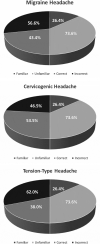Physical therapist clinical reasoning and classification inconsistencies in headache disorders: a United States survey
- PMID: 31373539
- PMCID: PMC7006737
- DOI: 10.1080/10669817.2019.1645414
Physical therapist clinical reasoning and classification inconsistencies in headache disorders: a United States survey
Abstract
Objective: The purpose of this study was to investigate the decision-making processes of physical therapists relating to evaluation and categorization of patients with headaches, including consistency with criteria proposed by the International Headache Society (IHS).Methods: A national online survey was distributed in cooperation with the Academy of Orthopaedic Physical Therapy of the American Physical Therapy Association. Three hypothetical patient case vignettes featuring headache disorders were used as assessment instruments. Additionally, data on physical therapist education, clinical experience, manual therapy training, self-efficacy, and familiarity & consistency with IHS criteria were collected. Physical therapist identification and valuation of clinical features of headache disorders were also examined in the decision-making processes.Results: Among the 384 respondents, 32.3% classified the tension-type headache case consistent with IHS criteria. The cervicogenic and migraine headache cases were classified at 54.8% and 41.7% consistent with IHS categories, respectively. Experienced clinicians and those with formal manual training categorized patient presentations with greater consistency. Clinician familiarity with IHS classification criteria was low with 73.6% collectively somewhat and not familiar, while 26.4% of physical therapists were self-described as very or moderately familiar.Discussion: Clinicians' headache categorization was significantly affected by symptom misattribution and weighting of individual examination findings. Weighting by practitioners of clinical features varied markedly with greatest emphasis being placed on detailed manual examination procedures, including passive intervertebral movements. Inconsistencies in valuation of clinical features in headache categorization suggest a need for further formal education in physical therapy educational curricula and in post-graduate education, including of IHS criteria and classification.Level of Evidence: 2a.
Keywords: Headache; clinical reasoning; primary care.
Figures
Similar articles
-
American Headache Society members' assessment of headache diagnostic criteria.Headache. 2003 Jan;43(1):2-13. doi: 10.1046/j.1526-4610.2003.03002.x. Headache. 2003. PMID: 12864752
-
Chronic daily headache: correlation between the 2004 and the 1988 International Headache Society diagnostic criteria.Headache. 2004 Jul-Aug;44(7):684-91. doi: 10.1111/j.1526-4610.2004.04128.x. Headache. 2004. PMID: 15209691
-
Classification of primary headaches.Neurology. 2004 Aug 10;63(3):427-35. doi: 10.1212/01.wnl.0000133301.66364.9b. Neurology. 2004. PMID: 15304572 Review.
-
Headache diagnosis and treatment: A pilot knowledge and needs assessment among physical therapists.Headache. 2025 Jan;65(1):90-100. doi: 10.1111/head.14801. Epub 2024 Sep 4. Headache. 2025. PMID: 39228263
-
Cervicogenic headache: too important to be left un-diagnosed.J Headache Pain. 2015;16:6. doi: 10.1186/1129-2377-16-6. Epub 2015 Jan 20. J Headache Pain. 2015. PMID: 25604994 Free PMC article. Review.
Cited by
-
A Multimodal Conservative Approach to Treating Migraine: A Physical Therapist's Perspective.Curr Pain Headache Rep. 2023 Sep;27(9):329-337. doi: 10.1007/s11916-023-01140-3. Epub 2023 Jul 29. Curr Pain Headache Rep. 2023. PMID: 37515744 Review.
-
Effectiveness of Manual Therapy and Acupuncture in Tension-Type Headache: A Systematic Review.Cureus. 2021 Aug 31;13(8):e17601. doi: 10.7759/cureus.17601. eCollection 2021 Aug. Cureus. 2021. PMID: 34646653 Free PMC article. Review.
-
Effectiveness of Mulligan manual therapy over exercise on headache frequency, intensity and disability for patients with migraine, tension-type headache and cervicogenic headache - a protocol of a pragmatic randomized controlled trial.BMC Musculoskelet Disord. 2021 Mar 3;22(1):243. doi: 10.1186/s12891-021-04105-y. BMC Musculoskelet Disord. 2021. PMID: 33657998 Free PMC article.
-
Associations between Fatty Acid Intake and Tension-Type Headache: A Cross-Sectional Study.J Clin Med. 2022 Dec 1;11(23):7139. doi: 10.3390/jcm11237139. J Clin Med. 2022. PMID: 36498721 Free PMC article.
-
Accuracy of migraine diagnosis and treatment by neurologists in the Baltic states: e-survey with clinical case challenge.Eur J Med Res. 2023 Dec 18;28(1):600. doi: 10.1186/s40001-023-01555-z. Eur J Med Res. 2023. PMID: 38110980 Free PMC article.
References
-
- Stovner L, Hagen K, Jensen R, et al. The global burden of headache: a documentation of headache prevalence and disability worldwide. Cephalalgia. 2007;27(3):193–210. - PubMed
-
- World Health Organization . Headache disorders. World Health Organization; Published 2016. [Updated 2016 April; cited 2017 August8]. Available from: http://www.who.int/mediacentre/factsheets/fs277/en/.
-
- Global Burden of Disease Study C . Global, regional, and national incidence, prevalence, and years lived with disability for 301 acute and chronic diseases and injuries in 188 countries, 1990-2013: a systematic analysis for the global burden of disease study 2013. Lancet. 2015;386(9995):743–800. - PMC - PubMed
-
- Diamond S, Bigal ME, Silberstein S, et al. Patterns of diagnosis and acute and preventive treatment for migraine in the United States: results from the American migraine prevalence and prevention study. Headache. 2007;47(3):355–363. - PubMed
-
- Silberstein S, Loder E, Diamond S, et al. Probable migraine in the United States: results of the American migraine prevalence and prevention (AMPP) study. Cephalalgia. 2007;27(3):220–229. - PubMed
MeSH terms
LinkOut - more resources
Full Text Sources
Medical



